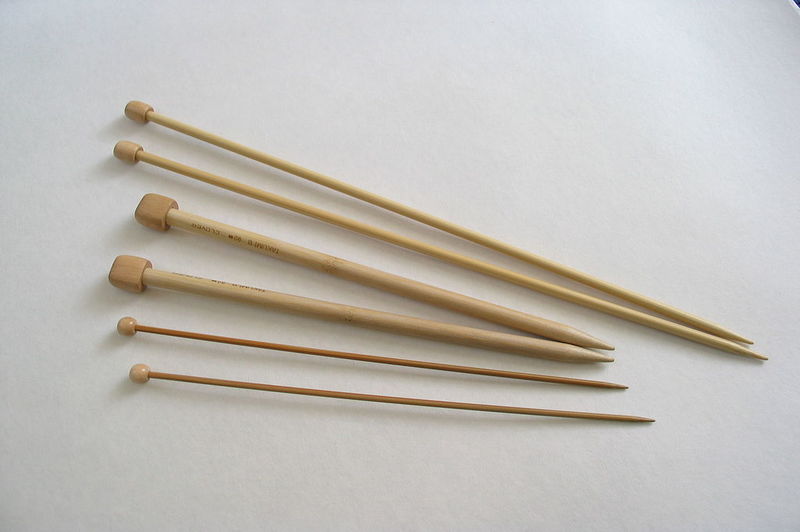Circular needles are a popular choice of what knitting needles to use for a blanket.

They are versatile and comfortable to use, but there is also a wide range of other knitting needles.
It’s all up to you which ones you feel are the most suitable for your project.
What Makes A Good Knitting Needle?
So, obviously, good knitting needles should hold all your stitches in place. However, they must be comfortable to use too.
Good knitting needles should be able to carry the blanket.
You may not notice, but when you are knitting, you constantly hold the weight of the stitches on your hands and wrists, which can cause fatigue without the help of a comfortable needle.
The way you knit a blanket is also a factor in the type of needle you should use. You could be knitting it in one piece or combining different parts together.
All of these factors can influence which type of knitting needle you should use.
What Knitting Needles To Use For A Blanket?
There are various knitting needles to choose from, and they come with their own benefits; you can adjust depending on your craft needs.
These are the types you can choose:
- Circular needles
- Straight needles
- Cable needles
- Double-pointed needles
- Interchangeable needles
Some people even use Bamboo needles, especially for chunky blankets.
You will get more in-depth information about circular needles as it’s the most recommended.
What Size Needles Do You Need For A Blanket?
So, how big should your needles be? Is a bigger or smaller size better?
There is no standard size for knitting needles, as it depends on the pattern you’re making.
You must also consider the type of yarn you’re using; bulky fabric will need a larger needle.
Large wool and needles will let your project finish faster; that’s why they are popular choices among knitters.
Once you’ve established your pattern and the type of wool, you can start pairing them with the perfect needles.
Benefits Of Using Circular Needles
So, what’s the fuss about circular needles? Why does everyone love using them?
Circular needles have a flexible cord that connects them in the middle.
It’s primarily used for round crafts like hats or sweaters, but they work great for flat projects like blankets too!
They are great for a large blanket because the center cord will support the weight of the yarn.
You won’t feel wrist pain anymore, and you can be confident that the needles will hold all your stitches in place.
They are also easy to use because you don’t have to turn your craft around when you finish a row. It will save you so much precious time.
This needle is usually between 16 to 48 inches long, but there are other sizes available too.
The cord thickness can also vary as if every needle is custom-made for you!
Fixed circular needles
This type of circular needle has the cord permanently attached in the middle.
It works well for blankets, but you may have to constantly change the needle with every blanket you make.
Interchangeable circular needles
These needles can be removed to easily change it or the cord. It usually comes in sets of different cord lengths and needle sizes.
These needles are great for your crafts because you don’t have to keep on buying new needles!
You can customize the length and thickness for whatever project you need.
Step-By-Step Process On How To Knit With Circular Needles
Now, it’s time to test if these needles live up to their reputation. Test them out by making your own blanket!
Step#1: Get your materials ready
Prepare your yarn, circular needle, blanket pattern, and ruler.
A handy tip to remember is the metal circular needles do work faster than other types. This is because the smooth surface allows the fabric to slide through.
Step#2: Cast the stitches
Start at the left-hand needle; the stitches will start sliding down the cable when there are many.
There won’t be any tension on your hands and wrists. The number of stitches depends on the pattern you will put on your blanket.
Step#3: Start knitting your blanket
After casting, you can start the main work. Knit the first row on the left-hand side, then switch the needles between your hands.
Next, slide the yarn between the two needles and knit the second row.
Then, switch the needles between your hands again and slide the yarn through. Continue this process until you’re finished with your pattern.
Step#4: Check the gauge
When you’re finished, use your ruler to check the gauge or the number of stitches per inch. Make sure it’s according to the instructions and make changes if necessary.
Step#5: Cast off and finalize your blanket
Secure the stitches, so they don’t unravel and tie the ends in. You may use a yarn needle to weave the ends into the stitches.
Now you’re done! That was really easy, wasn’t it?
Conclusion
Your projects will be easy when you know what knitting needles to use for a blanket.
Circular needles are the best choice, but you can use other types if you’re comfortable with them.
What’s important is your hands will be protected, and your blanket will look like a work of art.
